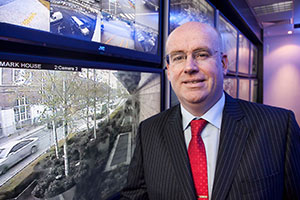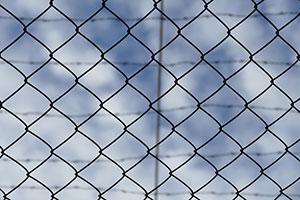The Museums Association Esmee Fairburn Collection Fund has awarded £120,000 to the National Justice Museum to introduce its unique 200-year-old HM Prison Service collection to a wider audience.
The funding supports a three-year project ‘Ingenuity, Creativity, Hope’ involving people in… more
Niall Kelly, CIO of Netwatch Group, discusses the relationship between prison standards and comprehensive video surveillance:
The capabilities of modern video surveillance technology are staggering. Across the prison estate, they are enabling occupational capacity with unprecedented standards of surveillance that go hand in hand with good governance and help to achieve the highest standards of control and safety.
Comprehensive monitoring makes the most of valuable human resources and mitigates the ever-present risks presented by overcrowding, violence, drug use and accusations of misconduct. Huge advances in digital signalling, video analytics, cloud processing, AI and deep learning are combining to enable proper stewardship of far-flung, secure areas.
Not that long ago, a CCTV system was no different to a broadcast television system. The circuit, ie the camera linked to the monitor, was a simple closed network, with a one way flow of information and zero feedback to the camera in terms of what information was required by the operator.
As CCTV systems changed from analogue devices to high speed IP (internet protocol) systems, the sheer amount of information they could convey rose exponentially. Where an old analog camera from only 15 years ago, with a resolution of 320 x 240 (7680 Pixels, or dots), was the norm, today even the cheapest systems feature a megapixel camera with the power to process more than 700 times that amount of information. A commonplace 5MPXL model now boasts a resolution of 2540 x 2048, enough to give highly accurate facial recognition.
The advent of such huge amounts of storage space, often held in the cloud, also allows greater retention times. From humble old VHS tapes, digital systems now enable almost limitless storage, with years of footage archived and stored and instant retrieval made possible. A client in the biotech sector is mandated to hold up to four years of footage in the cloud, or off site. 
Perhaps the greatest development of late, however, comes in the use of intelligent video analytics, whereby sophisticated computer algorithms analyse footage automatically against predefined rules, alerting operators to unusual patterns of behaviour.
In a prison environment, such analytic strengths can be very advantageous. A camera can learn the pattern of movement in an area, for instance down a corridor, and after a period, can “understand” the normal scene behaviour. If a person in that scene moves unusually, for instance against the flow, or quicker than usual, or perhaps two or more people huddle together or even start acting aggressively, the camera can quickly recognise the changes in the scene and raise an alert, which is then networked over the internet in real time across operational stations.
Furthermore, other cutting-edge technologies such as audio processing can now link to that video, and listen out for specified sounds, such as raised voices and shouting, or even recognizable patterns such as gunshots.
Modern facial recognition systems linked to intelligent access control systems are also increasingly apparent in many modern prison environments, alongside other tightly guarded, secure and highly controlled areas in military and other specialised sectors. Each entrant in to an area can now be scanned for facial recognition and imagery can be immediately compared to databases for alerts against certain specific criteria, for instance, whether a person should be in a certain spot at a certain time.
These algorithms are becoming ever more intelligent. They can now identify anomalies at great distances and in very crowded areas. The same technology that monitors a playground for children’s slips and falls, or a care home for a fall by a frail older person, is now in operation in open prison areas, in catering halls, common or outdoor areas.
Even the highest levels of operational security intelligence can sometimes bite off more data than they can cope with, and the same challenges apply in all sectors that come to depend on it. False alerts are a commonplace bugbear in environments where many hundreds of cameras might be in operation, when they are not used correctly.
A team of monitoring officers controlling a large network of cameras in a prison would not react well to hundreds of false alerts from their dispersed CCTV system, so we have invested heavily to reduce such false alerts. Our monitoring hubs receive analysis patterns taken from more than 100,000 monitored cameras installed worldwide, using cloud based algorithms specifically to recognise certain alarms, and provide clarity by filtering out alerts caused by extraneous events, from wildlife to foliage and other natural phenomena that might resemble human activity on a dark night at a distance.
Such offsite monitoring capabilities provide valuable support for prison facilities with complex, internal and external environments. Secure offsite facilities, certified by organisations such as BS and UL, now act as secondary control positions that can be pressed into service instantly in the event of incidents, with remote video surveillance, remote access to electronic access control systems and gates, doors, lighting and HVAC systems, all from secure offsite locations to which staff can be seconded in the event of emergencies.
Moore’s law, the often quoted formula that predicts the doubling of computing power and processing speeds in two-year cycles, applies as much to CCTV networking as it does to every other technology. 5G and IOT will guarantee its trajectory. Truly successful applications, however, in preventing terrorism, crime and anti social behaviour in society as much as in prisons, depend less on emerging technology applied for its own sake, and more on how it is applied to meet defined objectives. How that tech is configured is a question for human judgment, and every Governor will have specific issues to address. One thing is constant however. Never before have prison authorities been able to turn to such an intelligent guardian with which to help them cope with the multiple pressures placed upon them.



